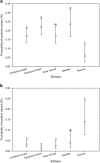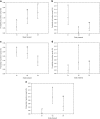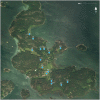The importance of study duration and spatial scale in pathogen detection-evidence from a tick-infested island
- PMID: 30482899
- PMCID: PMC6258729
- DOI: 10.1038/s41426-018-0188-9
The importance of study duration and spatial scale in pathogen detection-evidence from a tick-infested island
Abstract
Ticks (Acari: Ixodoidea) are among the most common vectors of zoonotic pathogens worldwide. While research on tick-borne pathogens is abundant, few studies have thoroughly investigated small-scale spatial differences in their occurrence. Here, we used long-term cloth-dragging data of Ixodes ricinus and its associated, known and putative pathogens (Borrelia burgdorferi s.l., Borrelia miyamotoi, Anaplasma phagocytophilum, Rickettsia spp., Candidatus Neoehrlichia mikurensis, Bartonella spp., Babesia spp., and tick-borne encephalitis virus, TBEV) from a small, well-studied island in southwestern Finland to analyze potential temporal and spatial differences in pathogen prevalence and diversity between and within different biotopes. We found robust evidence indicating significant dissimilarities in B. burgdorferi s.l., A. phagocytophilum, Rickettsia, and Ca. N. mikurensis prevalence, even between proximal study areas on the island. Moreover, during the 6 years of the ongoing study, we witnessed the possible emergence of TBEV and Ca. N. mikurensis on the island. Finally, the stable occurrence of a protozoan pathogen that has not been previously reported in Finland, Babesia venatorum, was observed on the island. Our study underlines the importance of detailed, long-term tick surveys for public health. We propose that by more precisely identifying different environmental factors associated with the emergence and upkeep of enzootic pathogen populations through rigorous longitudinal surveys, we may be able to create more accurate models for both current and future pathogen distributions.
Conflict of interest statement
The authors declare that they have no conflict of interest.
Figures




Similar articles
-
Prevalence of tick-borne pathogens in questing Ixodes ricinus ticks in urban and suburban areas of Switzerland.Parasit Vectors. 2017 Nov 9;10(1):558. doi: 10.1186/s13071-017-2500-2. Parasit Vectors. 2017. PMID: 29121976 Free PMC article.
-
Ticks are more suitable than red foxes for monitoring zoonotic tick-borne pathogens in northeastern Italy.Parasit Vectors. 2018 Mar 20;11(1):137. doi: 10.1186/s13071-018-2726-7. Parasit Vectors. 2018. PMID: 29554970 Free PMC article.
-
First records of tick-borne pathogens in populations of the taiga tick Ixodes persulcatus in Sweden.Parasit Vectors. 2019 Nov 28;12(1):559. doi: 10.1186/s13071-019-3813-0. Parasit Vectors. 2019. PMID: 31775857 Free PMC article.
-
Pathogens transmitted by Ixodes ricinus.Ticks Tick Borne Dis. 2024 Nov;15(6):102402. doi: 10.1016/j.ttbdis.2024.102402. Epub 2024 Oct 4. Ticks Tick Borne Dis. 2024. PMID: 39368217 Review.
-
Ticks and their epidemiological role in Slovakia: from the past till present.Biologia (Bratisl). 2022;77(6):1575-1610. doi: 10.1007/s11756-021-00845-3. Epub 2021 Sep 17. Biologia (Bratisl). 2022. PMID: 34548672 Free PMC article. Review.
Cited by
-
Recent establishment of tick-borne encephalitis foci with distinct viral lineages in the Helsinki area, Finland.Emerg Microbes Infect. 2019;8(1):675-683. doi: 10.1080/22221751.2019.1612279. Emerg Microbes Infect. 2019. PMID: 31084456 Free PMC article.
-
Different environmental factors predict the occurrence of tick-borne encephalitis virus (TBEV) and reveal new potential risk areas across Europe via geospatial models.Int J Health Geogr. 2025 Mar 14;24(1):3. doi: 10.1186/s12942-025-00388-9. Int J Health Geogr. 2025. PMID: 40087786 Free PMC article.
-
Scrub typhus ecology: a systematic review of Orientia in vectors and hosts.Parasit Vectors. 2019 Nov 4;12(1):513. doi: 10.1186/s13071-019-3751-x. Parasit Vectors. 2019. PMID: 31685019 Free PMC article.
-
Ghosts of weather past? Impact of past and present weather-related factors on the seasonal questing activity of Ixodes ricinus nymphs in southwestern Finland.Parasit Vectors. 2025 Jul 14;18(1):283. doi: 10.1186/s13071-025-06911-y. Parasit Vectors. 2025. PMID: 40660308 Free PMC article.
-
There Goes the Neighbourhood-A Multi-City Study Reveals Ticks and Tick-Borne Pathogens Commonly Occupy Urban Green Spaces.Zoonoses Public Health. 2025 May;72(3):313-323. doi: 10.1111/zph.13208. Epub 2025 Jan 16. Zoonoses Public Health. 2025. PMID: 39821965 Free PMC article.
References
MeSH terms
LinkOut - more resources
Full Text Sources
Other Literature Sources
Miscellaneous
